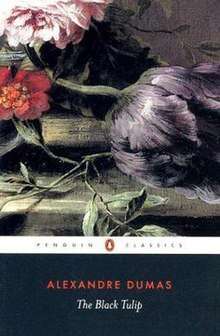The Black Tulip
The Black Tulip is a historical novel written by Alexandre Dumas, père.
 | |
| Author | Alexandre Dumas |
|---|---|
| Original title | La Tulipe Noire |
| Country | France |
| Language | Translated from French |
| Genre | Historical, Romantic |
| Publisher | Baudry, Paris 1850 |
Publication date | French 1850 |
| Pages | 234 p. (Penguin Classics Edition) |
| ISBN | 978-0-14-044892-4 (Penguin Classics Edition) |
| OCLC | 51528417 |
| 843/.7 22 | |
| LC Class | PQ2229.T8 E5 2003 |
Plot
The story begins with a historical event—the 1672 lynching of the Dutch Grand Pensionary (roughly equivalent to a modern Prime Minister) Johan de Witt and his brother Cornelis, by a wild mob of their own countrymen—considered by many as one of the most painful episodes in Dutch history, described by Dumas with a dramatic intensity.
The main plot line, involving fictional characters, takes place in the following 18 months; only gradually does the reader understand its connection with the killing of the de Witt brothers.
The city of Haarlem, Netherlands, has set a prize of ƒ100,000 to the person who can grow a black tulip, sparking competition between the country's best gardeners to win the money, honour and fame. Only the city's oldest citizens remember the tulip mania 30 years earlier, and the citizens throw themselves into the competition. The young and bourgeois Cornelius van Baerle has almost succeeded but is suddenly thrown into the Loevestein prison. There he meets the prison guard's beautiful daughter Rosa, who will be his comfort and help, and eventually become his rescuer.
The novel was originally published in three volumes in 1850 as La Tulipe Noire by Baudry (Paris).
Characters
- William, Prince of Orange, afterward William III. King of England.
- Louis XIV, King of France.
- Cornelis de Witt, inspector of dikes at the Hague.
- Johan de Witt, his brother, Grand Pensionary of Holland.
- Colonel van Deeken, aide-de-camp to William of Orange.
- Dr. Cornelius van Baerle, a tulip-fancier, godson of Cornelius de Witt.
- Mynheer Isaac Boxtel, his rival.
- Marquis de Louvois.
- Count Tilly, Captain of the Cavalry of the Hague.
- Mynheer Bowelt, deputy.
- Mynheer d'Asperen, deputy.
- The Recorder of the States.
- Master van Spenser, a magistrate at Dort.
- Tyckalaer, a surgeon at the Hague.
- Gerard Dow.
- Mynheer van Systens, Burgomaster of Haarlem and President of its Horticultural Society.
- Craeke, a confidential servant of John de Witt.
- Gryphus, a jailer, Rosa's father.
- Rosa, his daughter, in love with Cornelius van Baerle.
Reception
George Saintsbury described the novel as "charming in parts", but felt that Dumas had spun the story out to "an unconscionable length".[1]
Adaptations
The first screen adaptation appears to have been a silent 1921 Dutch-UK co-production directed by Maurits Binger and Frank Richardson. Alex Bryce directed a well-regarded UK adaptation of the novel in 1937, with Patrick Waddington as Cornelus Van Baerle. A five-part BBC miniseries debuted in August 1956 with Douglas Wilmer in the lead role. A second British miniseries appeared in September 1970. In 1988, Australia's Burbank production company created a 50-minute children's animated film from a bowdlerised version of the story.
In 1963, a movie called La Tulipe noire with actor Alain Delon was produced in France, but was not based on the novel. There was also a short Finnish documentary made by Pacho Lane in 1988 called The Black Tulip, but it told the story of Soviet soldiers fighting in Afghanistan.
A musical adaptation was written in 2004 by Kit Goldstein, and premiered at Union College in February 2005.
See also
- Assassinations in fiction
- Tulip mania
References
- The Fortnightly Review. Chapman and Hall. 1878. pp. 533.
External links
- The Black Tulip full text at Google Books
- The Black Tulip at Project Gutenberg
- eLook Literature: The Black Tulip - HTML version broken down chapter by chapter.
- Webpage for The Black Tulip musical at kitgoldstein.com.
